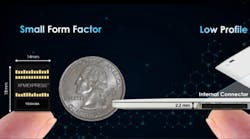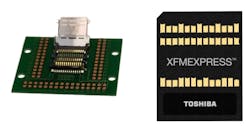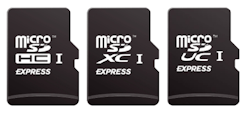Toshiba Memory, soon to be known as Kioxia, revealed XFMEXPRESS at this year’s Flash Memory Summit. The new form factor is about the side of an SD card (Fig. 1), but it’s designed for a PCI Express (PCIe) interface that supports x4 NVMe, the non-volatile memory express storage interface. Initial versions will support a bandwidth of 4 GB/s, while future generations promise to support 8 GB/s. The standard is designed for both PCIe Gen 3.0 and 4.0.
1. The socket (left) is designed to handle the XFMEXPRESS module (right) that has a x4 PCIe/NVMe interface.
The 14- × 18-× 1.4-mm form factor can be used in mobile devices, including tablets and laptops. It’s also ideal for embedded systems that require removable storage, such as in-vehicle infotainment (IVI) and advanced driver-assistance systems (ADAS). The socket is designed to be durable and flips up to accept a storage module (Fig. 2).
2. The XMFEXPRESS socket flips up to access a card. It locks in place when installed.
“Innovation like this is only made possible by redefining storage technology itself,” said Jeremy Werner, senior vice president and general manager, SSD Business Unit, Toshiba Memory America Inc. “From the PCB design to the connector, no other solution comes close to the combined size, speed, and serviceability of XFMEXPRESS technology. Toshiba Memory is excited to introduce this revolutionary new form factor to the market and enhance next-generation applications.”
“We believe that XFMEXPRESS technology is a great solution that will open new doors for innovative devices and applications in the information technology industry,” said Hajime Saito, associate senior vice president, Japan Aviation Electronics Industry Ltd. (JAE). “JAE is preparing the industry's first connector compatible with this memory device to support global hardware manufacturers who are interested in our new technology.”
XFMEXPRESS competes with SD and microSD Express cards (Fig. 3). These are defined in the SD 7.1 specification. The standard is based on PCI-SIG’s PCIe 3.1 and NVM Express’ NVMe v1.3 specifications. These cards provide higher throughput than the earlier UHS-II cards and both are faster than the original SD card interfaces. The SD and microSD Express cards provide a single-lane, PCIe x1 versus the x4 interface found on XMFEXPRESS.
3. SD Express and microSD Express (shown) cards support x1 PCIe/NVMe and legacy interfaces.





